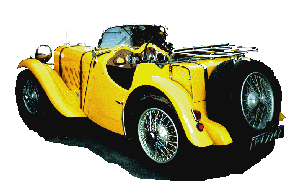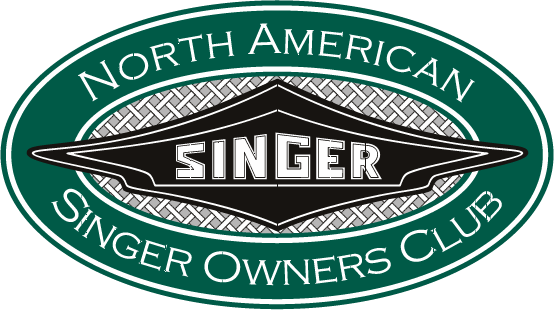1.5 Le Mans
In 1934 Singer introduced a six cylinder version of the popular Nine Le Mans at a price of 285 pounds. Like its baby sister, the 1.5 Litre had a compact two seater body with swept wings, a slab gas tank (increased in size from 12 to 15 gallons), stone guards on the gas tank sides and radiator and twin rear mounted spare tires. It used essentially the same double-dropped chassis as the Nine Le Mans, with modifications including the addition of one inch to the Wheelbase and special lightening and strengthening of the frame for competition and speed work. Room was made for the larger 6 cylinder engine by moving the seats back by several inches, which in turn necessitated shifting the second spare back over the rear cross member, instead of in the front as it was on the Nine. Larger 4.75 X 19 inch tires, replaced the 4.50 X 18’s that were standard on the Nine.
of the frame for competition and speed work. Room was made for the larger 6 cylinder engine by moving the seats back by several inches, which in turn necessitated shifting the second spare back over the rear cross member, instead of in the front as it was on the Nine. Larger 4.75 X 19 inch tires, replaced the 4.50 X 18’s that were standard on the Nine.
The engine had a capacity of 1493 cc.’s with a bore and stroke of 59 X 91 mm. Early models were fitted with twin downdraft S.U. carburetors and produced an output of about 48 b.h.p. Later versions were equipped with three horizontal carburetors, producing an output of approximately 63 b.h.p. The 1.5 Litre motor proved to be a smooth, virtually vibration-free and highly tractable engine, capable of pulling the car between 8 and 20 m.p.h. in either third or fourth gears without pinking. The 1.5 Litre Le Mans could cruise effortlessly at 70 m.p.h and was capable of speeds upwards of 80 m.p.h.
Singer’s newest entrant to the market proved to be an immediate success in competition. Two of the new 1.5 Litres were entered in the 1934 Le Mans taking second and third places in the Rudge-Whitworth Biennial Cup and finishing 7th and 8th overall. The following year Singer converted three of their 11/2 -Litre Le Mans Tourist Trophy cars to Trials and Rally cars for use by the Singer Works Team. Known alternately as the “Three Graces” and “This, That and T’other”, this works team was one of the most successful ever. These cars were particularly effective on the special tests and restarts where M.G., Austin and the big ford V-8’s struggled to match their times.
For 1935, a Le Mans 11/2 -Litre Special Mark II chassis was also available to the general public at a cost of 500 pounds ex works or with a complete two seater body for 595 pounds. Modifications included a special high compression cylinder head with larger diameter valves, a special cooling layout, triple carburetors, an external exhaust system built to competition standards, larger diameter racing drums and larger section racing rims, triple spoked to carry suitable racing tires.
Only 71 of the 1.5 Litre Le Mans Singers were ever produced.
1.5 Le Mans Specs
Engine
Six cylinder, 59 mm. by 91 mm. = 1493 c.c.
Treasury rating, 12.95 h.p.; tax 13 pounds
Valves operated by chain driven overhead camshaft
Alloy pistons
Le Mans Coil / Speed Magneto
Triple S.U. horizontal
Fan assisted cooling
Vibro damping engine mountings
Gearbox and Transmission
Lemans – Four speeds 4.44, 5.64, 9.08 and 17.7 to 1and 24:1 reverse
Speed – Four speeds 5.0, 6.35, 10.24 and 18.6 to 1and 25.25:1 reverse
Silent second and third gears
Remote control shift lever
Single dry plate clutch
Open propeller shaft with Hardy Spicer mechanical universal joints
Spiral bevel rear axle
Wheels and Brakes
18 inch Rudge-Whitworth knock on wheels
4.75 X 18 inch tires
Four wheel Lockheed hydraulic brakes, 13 inch drums
General
12 volt lighting and starting system
Wheelbase 7 ft. 8 ins. with 6.5 inch ground clearance
Price
Le mans 285 pounds / Speed 595 pounds
